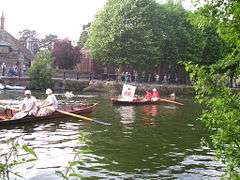Swan Upping

Swan upping is an annual ceremony in England in which mute swans on the River Thames are rounded up, caught, ringed, and then released.
History
By prerogative right, the British Crown enjoys ownership of all unmarked mute swans in open water. Rights over swans may, however, be granted to a subject by the Crown (accordingly they may also be claimed by prescription.)[1] The ownership of swans in a given body of water was commonly granted to landowners up to the 16th century. The only bodies still to exercise such rights are two livery companies of the City of London. Thus the ownership of swans in the Thames is shared equally among the Crown, the Vintners' Company and the Dyers' Company.
Description
Swan upping is the traditional means by which the swans on the Thames are apportioned among the three proprietors. Its main practical purposes today are to conduct a census of swans and check their health. It occurs annually in the third week of July. Over five days, the Queen's, Vintners' and the Dyers' respective swan uppers row up the river in skiffs in recent centuries from Sunbury-on-Thames to Abingdon on Thames.[2][3] Swans caught by the Queen's swan uppers under the direction of the Swan Marker are left unmarked, except for a lightweight ring linked to the database of the British Trust for Ornithology (BTO). Those caught by the Dyers and Vintners receive a similar ring on the other leg. Originally, rather than being ringed, swans' bills would be nicked using a metal implement, a practice reflected in the pub name The Swan with Two Necks in the City connected with the Vintners, a corruption of "The Swan with Two Nicks".
On 20 July 2009, Queen Elizabeth II, as "Seigneur of the Swans," attended the Swan Upping ceremony for the first time in her reign. This was the first time that the monarch had personally watched the ceremony in centuries.
In 2012, exceptional high river flows for summer prompted a partial cancellation: between Sunbury-on-Thames and Windsor, the first definitively known cancellation (albeit partial) in its 900-year history.[4]
.jpg) "Swan Upping on the Thames", from Henry Robert Robertson's Life on the Upper Thames, (1875)
"Swan Upping on the Thames", from Henry Robert Robertson's Life on the Upper Thames, (1875) A Queen's swan upper with a mute swan during 2010 swan upping at Henley-on-Thames
A Queen's swan upper with a mute swan during 2010 swan upping at Henley-on-Thames Swan marker of the Worshipful Company of Vintners, in his blue uniform, during 2011 swan upping, Abingdon.
Swan marker of the Worshipful Company of Vintners, in his blue uniform, during 2011 swan upping, Abingdon. Swan Upping at Cookham, by Stanley Spencer, oil on canvas, 1915-19
Swan Upping at Cookham, by Stanley Spencer, oil on canvas, 1915-19
See also
References
- ↑ The Case of Swans (1592) 7 Co. Rep. 15b
- ↑ Wheals, Brian Brenchley (1984). Theirs Were But Human Hearts: A Local History of Three Thameside Parishes. H.S. Publishing. p. 65. ISBN 0-9509053-0-5.
- ↑ The Queen's Swan Marker (2018), Royal Swan Upping, Trinityweb Ltd
- ↑ "Windsor Swan Upping ceremony cancelled due to flooding". BBC News.
- Norman Frederic Ticehurst, The Mute Swan in England: Its History, and the Ancient Custom of Swan Keeping (1957).
External links
![]()

.svg.png)